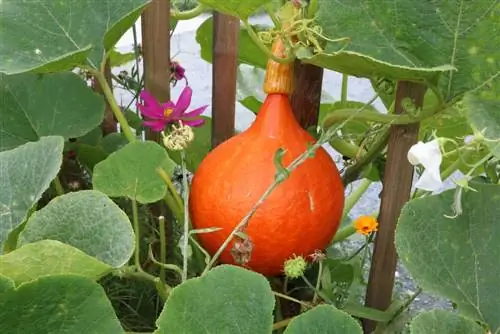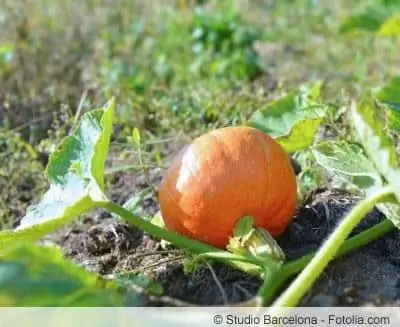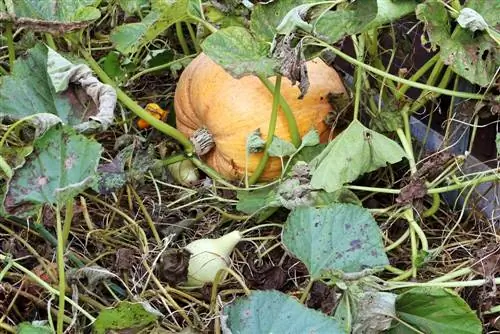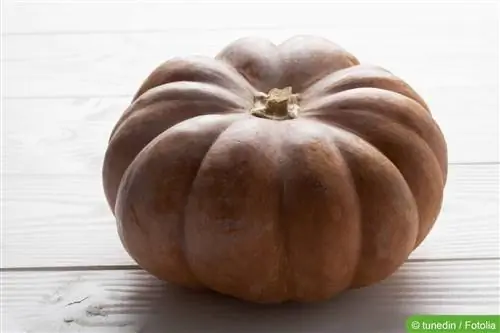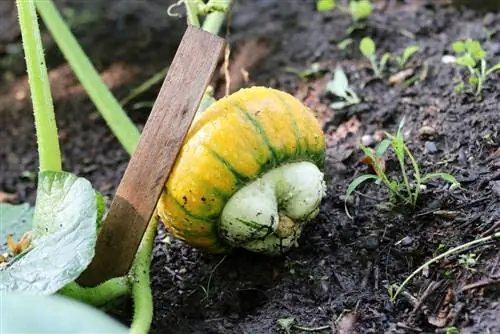- Author admin [email protected].
- Public 2023-12-17 03:39.
- Last modified 2025-01-24 12:45.
Chestnut, chestnut or onion pumpkin - the Hokkaido pumpkin, which comes from Japan, is known by numerous names. The vitamin-rich vegetables can be prepared in a variety of ways, and a relatively long storage time makes the pumpkins also interesting for occasional cooks. The multicolored representatives of Cucurbita maxima are also among the most popular pumpkins in our latitudes. The plant can easily be cultivated in your own garden as long as the location and care conditions are met.
Location and soil
The cultivated form from the Japanese island of “Hokkaido” is now one of the best-known pumpkins in our country. Its popularity is not only due to its aromatic taste. In contrast to other types of pumpkin, the peel of Hokkaido pumpkin can be processed directly. Only the inedible seeds must be removed before consumption. Cucurbita maxima prefers a sunny location in the vegetable patch or directly on the compost. If the plant receives too little light, the harvest yield and the growth of the pumpkins will visibly suffer.
Hokkaidos are among the highly consuming plants. The pH value plays a minor role if the soil is deep and extremely rich in nitrogen. So that the substrate can store moisture, you should mix in small amounts of clay in sandy soils. The pumpkins are also partially suitable for cultivation in planters. Here too, you should sufficiently improve the soil with humus before planting.
Watering and fertilizing
Standing wetness and long-term dryness take a huge toll on the Asian pumpkin variety. If the soil is compacted, you can use medium-sized pebbles as drainage. Watering is moderate, but regular. Especially on hot summer days, you should check the moisture content of the substrate in the morning and evening and rewater immediately if necessary. The root ball of the plant must under no circumstances be allowed to dry out.
The supply of nutrients and minerals plays an important role in the harvest yield and the growth of the highly consuming plant. If you mix manure and compost into the soil in the fall of the previous year, you will have ideal conditions for pumpkin plants. But you can also prepare the substrate with humus or horn shavings shortly before planting. From June to August, conventional garden fertilizer has proven to be extremely efficient. Apply this according to the package instructions.
Tip:
If you have the opportunity, you should cultivate the plants directly on the compost. Here the Hokkaido pumpkin plants find all the important nutrients and minerals.
Sowing and Planting
The Japanese representatives of Cucurbita maxima are annual, creeping plants with round stems and leaves. The plants are extremely sensitive to frost, so sowing outdoors should only take place after the Ice Saints in May. However, you can grow the plants on the windowsill as early as April. If available, you can use the dried pumpkin seeds from the previous year.
Sowing with seeds
Hokkaido is extremely germinative, so theSeed sprouts reliably in almost 95% of all cases.
- Use a lean substrate such as a soil and sand mixture.
- Press the seeds lightly into the soil.
- Keep substrate evenly moist.
- The humidity can be increased with a transparent, perforated film.
Planting through seedlings
As soon as theseedlings have reached a height of around 5 cm, you should prick them out and place them individually in planters. This will prevent the roots from growing together. When planting several pumpkin plants, you should maintain a minimum distance of around 100 cm. This means that the plants do not compete with each other for water and sunlight and can develop optimally. When planting outdoors, you should proceed as follows:
- Enrich the substrate in the flowerbed with larger amounts of humus and compost.
- Insert pumpkin plants into the planting hole up to the upper root collar.
- Fill back the soil and gently press it down.
- Pour vigorously.
- Apply sawdust to prevent snail infestation.
The last measure is optional, but the slimy garden inhabitants also literally like to eat pumpkins. Without certain precautions, traces of damage to the fruit are not uncommon. If several different pumpkin varieties are cultivated in the immediate vicinity, there is a possibility that they will cross each other and no single-variety fruit will be produced. This is by no means harmful to human he alth, but it can affect the taste and appearance of individual pumpkins.
Cutting
Classic pruning does not have to be done on annual plants. However, the plants tend to develop excessively long tendrils in summer. The growth of these shoots can have a negative impact on flower and fruit production. Therefore, shorten non-flowering tendrils with a sharp knife or scissors.
Harvest
As soon as the first fruits appear, you should protect them from rot and snail damage. Depending on the variety, Hokkaido pumpkins can reach a weight of up to 8 kg. This makes it difficult to tie the fruit up. Pallets, bark mulch or a thick layer of sawdust are much more effective. The harvest takes place between September and December. As soon as the plant parts die off, the pumpkins can be harvested. Another way to determine the ripeness of the fruit: tap the pumpkin. If the sound is dull and hollow, the pumpkin is ripe and needs to be turned or cut. Leave about 5 centimeters of stem on the fruit. Depending on the variety, you can store Hokkaidos for up to 8 months. Storage should take place in a dry and cool place; the ambient temperature must not fall below or exceed 10 to 15 °C. Store the pumpkins on pallets to avoid rot on the bottom.
Varieties
There are different varieties of Hokkaido pumpkin, all of which differ in weight, appearance and taste. The most popular breeding forms include:
- “Maina di chioggia”: Can reach a weight of up to 8 kilograms. Depending on the location conditions, you can store the pumpkins of this Hokkaido variety between 4 and 8 months.
- " Red Kuri": Also known as "Uchiki Kuri", it is probably the most common Hokkaido variety in home gardens and supermarkets. The pumpkin has orange flesh and a striking red outer shell. The taste is nutty-sweet and slightly floury.
- “Kuri Kabocha” This green pumpkin has a slightly ribbed surface and bright yellow flesh. The weight is about 2 to 3 kilograms.
- “Yukigeshou”: A decorative variety with a gray-marbled shell. Aromatic and firm pulp.
Conclusion
Hokkaido pumpkins are a versatile and he althy treat. The vitamin-rich vegetables are not only easy to prepare, but can also be cultivated in your own garden without much effort. However, one of the most important prerequisites for a productive harvest is a high nutrient content in the soil. Save yourself the hassle of preparing the soil and the regular supply of artificial fertilizer by planting the Hokkaido plants directly on the compost.
What you should know about Hokkaido pumpkin in brief
Varieties
- Red Hokkaido named Red Kuri
- Green Hokkaido Sweet Mama
- Green Hokkaido Nutty Delicia
- Hokkaido pumpkin Maina di Chioggia
The first three Hokkaido varieties all weigh between 1, 5 and 2 kilograms while the Hokkaido pumpkin Maina di chioggia can weigh up to 8 kilograms. The varieties of Hokkaido pumpkin also differ in their storage time. The Hokkaido pumpkin Red Kuri can be stored for 5 months, the Hokkaido pumpkin Nutty Delicia for 4 to 6 months and the Maina di chioggia for 4 to 8 months, while the Hokkaido pumpkin Sweet Mama can be stored for a full 12 months.
The Hokkaido pumpkin, as the name suggests, comes from the Japanese island of Hokkaido. It is one of the edible pumpkin varieties and has an average weight of 1.5 to 2 kilograms.
Usage
- Unlike other edible pumpkin varieties, Hokkaido pumpkin can be cooked with the peel on and then eaten with the peel on.
- Its taste is slightly nutty and the consistency of the pulp is firm.
- The Hokkaido can be used in savory dishes such as gratins and soups, but can also be eaten raw.
- Before preparation, you should remove the seeds from the flesh of the Hokkaido pumpkin as they are not edible.
Sowing
- The Hokkaido pumpkin is sown in the month of May after the Ice Saints
- This pumpkin variety, like all other edible pumpkin varieties, can be damaged by frost.
- To grow the plant for growing Hokkaiod pumpkin, you should use a peat soaking pot or, if not available, a multi-pot plate.
- These growing materials can be placed in the ground together with the plant and the roots of the Hokkaido pumpkin plant remain undamaged.
Cultivation and care
- After about one to two weeks of cultivation, the Hokkaido pumpkin plants can be planted outside.
- As already mentioned, transplanting outside should only be carried out after the Ice Saints.
- When planting the Hokkaido pumpkin, it is important that there is around one to one and a half meters of space between each plant.
- The plants must receive enough light and their roots must be able to spread unhindered.
- The best planting medium for Hokkaido pumpkin is compost. The humus ensures the optimal supply of nutrients for the pumpkin.
- You should also make sure that the Hokkaido pumpkin always gets enough sunlight and water during its growth.
- The soil should always be slightly moist.
Tip:
If you don't have a compost heap available for planting Hokkaido pumpkins, you can also plant the pumpkin plants in a bed. In this case, the soil must also be fertilized with garden compost to ensure the necessary nutrient supply for the Hokkaido pumpkins.
Harvest
- Hokkaido pumpkins are harvested from September to December.
- You can find out whether a Hokkaido pumpkin is ripe by doing the tap test.
- If you knock on the skin of the Hokkaido pumpkin and you hear a hollow sound, you know that the pumpkin is ripe.
- As with all other types of pumpkin, Hokkaido pumpkins should be stored in a cool and dry place.
- The temperature of the storage room should be between 10 and 13 °C and not lower or higher.
- You should also store the Hokkaido pumpkins on wooden panels. Hokkaido pumpkins can be stored for around 4 to 6 months.

